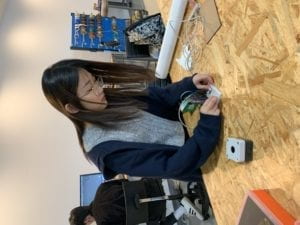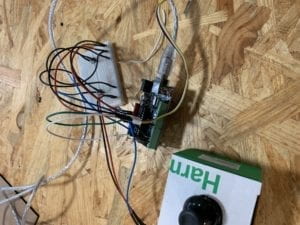
 Project Title: You Are the Superhero!
Project Title: You Are the Superhero!
Partner: Eugene
Instructor: Young
At first, we set all three heroes controlled by buttons. However, after the user test, we found that the game was too unfair for the villain to win because the user who controls the superheroes can simply press all three buttons and Thanos would have little chance to escape. Therefore, we replaced the middle button with a voice sensor. When the db it detected exceeds 95, the middle hero would shoot. Because the voice sensor was quite small and user had to bend over to reach it, I put the voice sensor in a prop microphone. For the prop microphone, I used plastic because this material could be easily to buckle and tailor. A metallic microphone or a 3D print microphone were also two options for us. However, after screening, we still thought that plastic microphone was the best option because the voice sensor had to be sticked on the top inside of the microphone to better capture the voice from the user. And both metallic microphone and 3D print microphone were too hard for the scissors to cut to put the voice sensor inside. Another adjustment we made according to the user test was changing the size of the buttons.at first, we used the small buttons in the kit and they were hard to reach on the breadboard because of the dense jumper cables. Therefore, we borrowed two white buttons, whose radius was approximately 2 centimeters to better tailor to the hand size of the users.
The most significant steps in our production process was coding. We met problems mainly in communication between me and my partner. Because coding was a relatively subjective process and needed to continuously referring back to the previous part. Each one of us had a coding system and different ways to set variables in our mind and let my partner to understand the part of the code the you wrote was actually difficult and time-consuming. We also met difficulties in the process of producing the device. We planned to make two boxes, one was for the user to control the villain and the other was for another user to control the three superheroes. Because joystick was everything that user needed to move the villain, so I made a small cubes with side length of 10 centimeters, using the laser cut. I left a circle on the top of the box to let the joystick went through and a square on one side of the box to let jumper cables went through. However, in the user test, we found the problem that the jumper cable was not stable if only use the double-sided tape to stick it on the top from the inside. If the user pressed hard, the joystick would fall. So I cut some small square of cardboard and put them inside the box to support the joystick.
The main goal of our project is to provide a relaxes for the lovers of this series in their leisure time. Our intended audience is the young generation who favors the Marvel series movies and also game lovers. And this sort of shooting game exercise their responsiveness. In my opinion, the project aligns with my definition of interaction, which is two or more objects listen, understand and respond to each other. The project has all these three steps. When the user pushes the button, the computer analyzes the circuit and the code to run the correct animation and produce the effect. However, it is not only a one-way interaction. The user also has to observe the position of the villain so as to hit it precisely and defeat him as soon as possible. When it comes to what doesn’t align with my definition of interaction, I think the way to interact in this project is not plural enough, with only two ways which are pressing and shouting. It also doesn’t embody my opinion of a strong interactive project, which requires real-time interaction. If I had more time, I would add a face detect function in the end of the game. If the superheroes win, the camera will capture the user’s face and put it on the top of a costume of one of the three superheroes. And if the Thanos wins, the user will also “wear” like Thanos. This function will make the interaction in my project more real-time. From the process of producing my final project, I gained a lot, not only in the academic aspect,, but also the way to corporate with a partner. My awareness of the importance of a rational division of labor was developed and this can benefit me in my future way of academic learning.